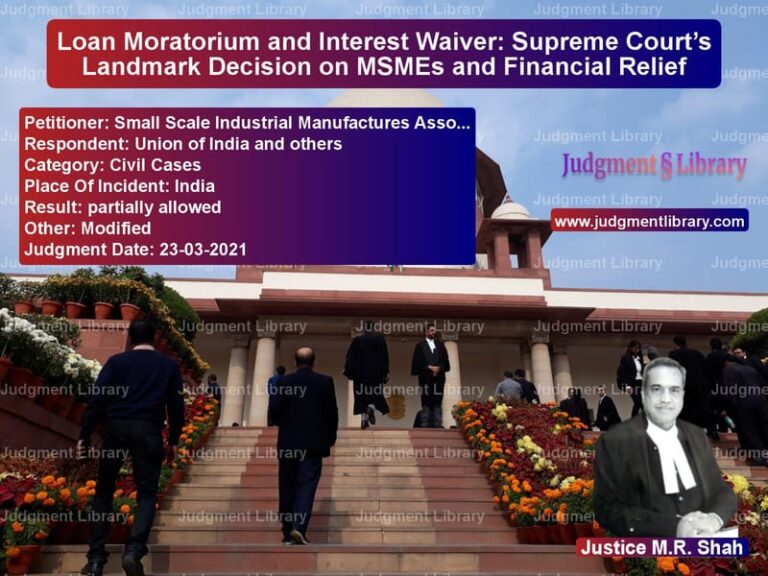Murder Conviction and Criminal Conspiracy: Analyzing the Case of Harpal Singh
The Supreme Court case of Harpal Singh vs. State of Punjab delves into a gruesome murder and criminal conspiracy that led to a conviction under Sections 302 and 120-B of the Indian Penal Code (IPC). The judgment discusses the events leading up to the crime, the evidence presented, and the legal reasoning behind the conviction. This case underscores the role of circumstantial evidence, eyewitness testimonies, and forensic findings in securing a conviction in a criminal case.
The case originated from a crime committed on the night of April 2-3, 2000, in Amritsar, where Banarasi Dass was brutally murdered in his residence. The prosecution alleged that Harpal Singh, along with other co-accused, conspired and executed the crime for monetary gains. The victim was first strangulated and then stabbed, and valuables including gold ornaments and cash were looted from the residence. The primary witness, the victim’s wife, provided a detailed account of the crime, which was pivotal in the conviction.
Background of the Case
On April 3, 2000, a police patrol received information about a murder at the residence of Banarasi Dass. Upon arrival, the police recorded a statement from the victim’s wife, who recounted the harrowing details of the crime. She stated that two intruders, one a Sikh youth in a white kurta and another a clean-shaven man, entered their home at night. The Sikh youth first strangulated her husband and then inflicted multiple dagger blows. They then looted jewelry, cash, and other valuables before locking her in the bathroom and fleeing the scene.
The police investigation led to the arrest of multiple suspects, including Harpal Singh, Gulzar Singh, Bikramjit Singh, and Ashwani Kumar. Their confessions and subsequent recoveries of stolen items formed the basis of the prosecution’s case. Harpal Singh, in particular, was found in possession of significant amounts of gold and cash.
Arguments Presented
Petitioner’s Arguments
- Harpal Singh’s defense revolved around the argument that the money recovered from him was not linked to the crime but was instead proceeds from the sale of his mini-bus. He asserted that he had legally sold the vehicle for Rs. 3,80,000 to one Hakumat Singh and that the police had falsely implicated him by attributing the recovered money to the robbery.
- The defense also contended that there was no direct evidence linking Harpal Singh to the crime. The prosecution relied heavily on circumstantial evidence and recoveries, which were allegedly fabricated.
- Additionally, the petitioner challenged the validity of the identification process, claiming that the looted gold and cash were not uniquely identifiable and that their recovery was staged to falsely implicate him.
Respondent’s Arguments
- The prosecution maintained that Harpal Singh was directly involved in the criminal conspiracy and execution of the murder.
- They presented the testimony of Vinod Kumar Gambhir, son of the deceased, who identified the stolen items as belonging to his father.
- The prosecution emphasized the credibility of the eyewitness testimony of the victim’s wife, who described the assailants and the sequence of events in detail.
- The prosecution also highlighted forensic evidence and the medical report, which confirmed that the victim died from strangulation and multiple stab wounds.
Judgment and Legal Analysis
The Supreme Court upheld the conviction, finding that the prosecution had established the guilt of the accused beyond a reasonable doubt. The court noted that the testimonies of key witnesses, combined with forensic evidence and recoveries, pointed unequivocally to the involvement of the accused.
The court reasoned that:
- The testimony of the victim’s wife was consistent and credible, providing a direct link to the crime.
- The presence of stolen items in the possession of the accused was strong corroborative evidence.
- The alleged explanation of an alternative source for the recovered money was not sufficiently supported by evidence.
Accordingly, the appeal was dismissed, and the conviction of Harpal Singh was upheld.
Conclusion
This case serves as a critical precedent in demonstrating how circumstantial evidence, witness testimonies, and forensic findings collectively contribute to the conviction of individuals involved in heinous crimes. The judgment reinforces the principles of criminal jurisprudence by ensuring that justice prevails based on a thorough and meticulous examination of evidence.
Petitioner Name: Harpal Singh.Respondent Name: State of Punjab.Judgment By: Justice Indira Banerjee, Justice J.K. Maheshwari.Place Of Incident: Amritsar, Punjab.Judgment Date: 04-07-2022.
Don’t miss out on the full details! Download the complete judgment in PDF format below and gain valuable insights instantly!
Download Judgment: harpal-singh-vs-state-of-punjab-supreme-court-of-india-judgment-dated-04-07-2022.pdf
Directly Download Judgment: Directly download this Judgment
See all petitions in Murder Cases
See all petitions in Bail and Anticipatory Bail
See all petitions in Attempt to Murder Cases
See all petitions in Fraud and Forgery
See all petitions in Theft and Robbery Cases
See all petitions in Judgment by Indira Banerjee
See all petitions in Judgment by J.K. Maheshwari
See all petitions in dismissed
See all petitions in supreme court of India judgments July 2022
See all petitions in 2022 judgments
See all posts in Criminal Cases Category
See all allowed petitions in Criminal Cases Category
See all Dismissed petitions in Criminal Cases Category
See all partially allowed petitions in Criminal Cases Category







